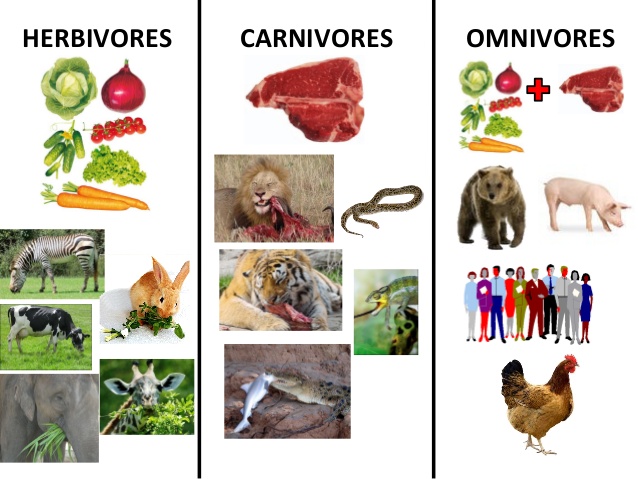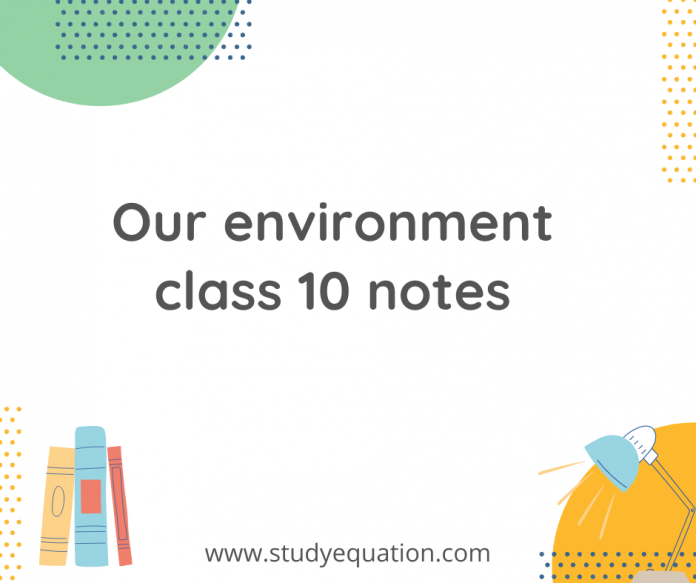Our environment class 10 notes – These notes involve explanations of the various components of out environment. It is on the types of wastes, ecosystems and garbage disposal mechanisms. It shows us the importance of our ecosystem and the need for the food chains to be maintained.
Table of Contents
Biodegradable waste – Our environment class 10 notes
Substances that are broken down by the biological processes are said to be biodegradable. These substances are decomposed through the actions of fungi, bacteria, and other living organisms. For example: Food waste, trees leaves, paper, etc
Non-Biodegradable Wastes
They persist in the environment for a long time and may harm the various members of the ecosystem. For example: insecticides, pesticides, mercury, radioactive wastes, etc.
Difference between Biodegradable and Non-Biodegradable wastes
| Biodegradable wastes | Non-Biodegradable wastes |
| 1. The wastes that are broken down naturally by microbial action. | 1. The wastes that are not broken down by the microbes. |
| 2. Biodegradation forms harmless and non- poisonous products. | 2. No such action is possible. |
| 3. They release raw materials back to nature. | 3. They do not release raw materials. |
| 4. They pollute the environment only when they are produced in quantity beyond the capacity of the environment to degrade them. | 4. Non-biodegradable wastes pollute the environment even in small quantity. |
| 5. Bioconcentration does not occur. | 5. Bioconcentration or biomagnifications occurs when wastes enter food chains. |
| 6. Recycling is possible both naturally or through human efforts. | 6. Recycling is possible only through human efforts. |
Ecosystem
An ecosystem is a self-contained unit of living things (plants, animals and decomposers), and their non-living environment (soil, air and water). For example: a forest, a pond, a lake, a green land etc.

Components of the ecosystem – Our environment class 10 notes
Biotic component:
It includes three types of organisms :
1. Producers: All green plants, blue green algae can produce their food (Sugar and starch) from inorganic substance using light energy (Photosynthesis). Therefore, all green plants are called producers (also called autotrophs).
2. Consumers: They are organisms which consume other organisms or their products as their food. All animals belong to this category. Thus the consumers depend upon producers for their food directly or indirectly. They get their food by eating other organisms or their products.
- Herbivores: are organisms (animals) which get their food by eating the producers directly (also called first order consumers). Some common examples of herbivores are : deer, rabbit, rat, squirrel, goat, cattle, etc.
- Carnivores: These are organisms (animals) which consume other animals. Therefore, carnivores feed on the flesh of herbivores (also called primary carnivores or second order consumers). Some common examples are snake, wild cat, jackal, frog, some birds, fishes, etc. There are animals which prey upon primary carnivores (also called second order consumers or third order consumers). For example, owl, peacock, tiger, lion, etc., are some second order carnivores and may be eaten by third order. The carnivores that are not preyed upon further are top carnivores. For example, lion is a top carnivore.
- Omnivores: The organisms which feed on both plants and animals are omnivores. Human beings are common example of omnivores because they eat both plants (For example; pulses, grams, oilseeds, fruit, etc.) and animal products (milk, meat, egg, etc.).

Abiotic Components
These are non-living components of an ecosystem. These include the physical environment.
- Edaphic factors like soil texture, topography, water, and air.
- Inorganic substances like carbon dioxide, nitrogen, oxygen, water, phosphorus, sodium, potassium, and calcium. These are involved in the cyclic of materials in the ecosystem.
- Organic compounds like proteins, carbohydrates, and lipids. These largely form the living body and link the abiotic and biotic components.
Decomposers
Fungi and bacteria which break down (decompose) the dead plants, animals complex compounds into the simpler one. The decomposers help in the replenishment of natural resources (also known as microorganism or saprotrophs or reducers).
Also Read : Heredity and Evolution Class 10 Notes Science Chapter 9
Importance of Decomposers
- Decomposers help in disposing of the wastes and dead bodies of plants and animals. Therefore, they clean the environment and create space for a living of newer generations of organisms.
- The decomposers release minerals and other raw materials trapped in organic matter. These are picked up by plants. This also helps to maintain the fertility of soil.
- The decomposers produce some acids which are useful in solubilization of some minerals.
- Decomposers help in recycling the materials in the biosphere so that, the process of life may go on and on like an unending chain.
Food chain – Our environment class 10 notes
- The study of food chains helps in understanding food relationships and interactions among the various organisms in an ecosystem. They transfer energy and materials between various living components of an ecosystem.
- Food chains transfer energy and materials between various living components in an ecosystem or biosphere.
- The food chains give dynamicity to an ecosystem or biosphere.
- The movement of toxic substances like pesticides, weedicides, etc., through food chains, can prove very harmful.
Food Web
The inter-connected food chains operating in an ecosystem which establish a network of relationship between various species, are called food web.
In a food web, one organism may occupy a position in more than one food chain. An organism can obtain its food from different sources and in turn, may be eaten up by different types of organisms.

Trophic Levels – Our environment class 10 notes
The various steps in the food chain at which the transfer of food (or energy) takes place is called trophic levels.
There is a gradual decrease in the amount of energy transfer from one trophic level to the next trophic level in a food chain.
Energy flow
- Transfer of energy from one trophic level to another depicting its direction and amount.
- Can be represented by the pyramid of energy and in any food chain, only 10% of the energy is transferred from one trophic level to another.
Environmental Problems
Changes in the environment affect us and our activities change the environment around us. This led to the slow degradation of the environment that arose many environmental problems. For Example: depletion of the Ozone Layer and waste disposal.
Depletion of Ozone Layer
Ozone (O3) layer is largely found in the stratosphere which is a part of our atmosphere from 12 km -50 km above sea level called ozonosphere. It is deadly poisonous at the ground level.
Ozone layer is a protective blanket around earth which absorbs most of the harmful U.V. (Ultraviolet) radiation of the Sun, thus, protecting the living beings of the Earth from health hazards like skin cancer, cataract in eyes, weaken immune system, destruction of plants etc. The decline of Ozone layer thickness in Antarctica was first discovered in 1985 and was termed as OZONE HOLE.
Garbage Disposal
- Involves all the activities and actions required to manage waste from its inception to its final disposal.
- Ensures environmental best practices are followed along with proper monitoring and regulation.
Steps involved:
1. Segregation of waste
2. Collection
3. Transport
4. Treatment
5. Processing & Recycling
6. Disposal
Conclusion – Our environment class 10 notes
Our environment class 10 notes – These notes involve explanations of the various components of out environment as given above. It is seen that it is important to ensure that our environment does not get polluted and we maintain it so as to avoid ozone depletion.





